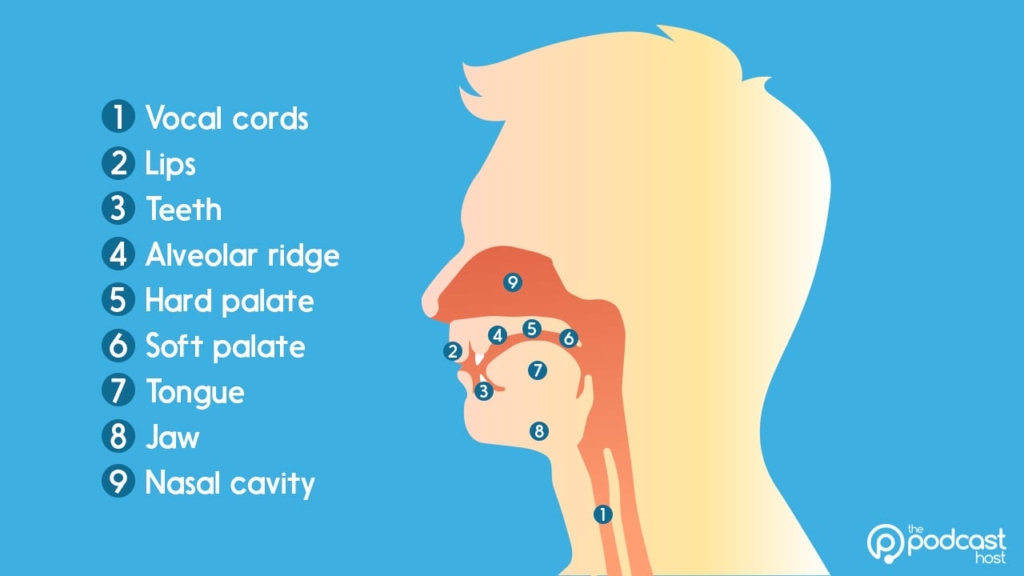Vocal Warm-Up Exercises: Ten Tips to Tame That Tripping Tongue

Everybody stumbles from time to time. But if you find yourself stumbling more frequently, or if you’d just like a few more tricks to tighten those vocal chops, here’s ten tried-and-true tips to training that tongue tendon. It’s our ultimate guide to vocal warm-up exercises for podcasters.
Note: I know it’s a frenulum, but that doesn’t roll off the tongue…
so to speak. TW: Alliteration and dad jokes ahead. Strap in.
1. Practice and Preparation
The key to mastering any instrument is practice. Whether for speaking or singing, the human voice, as an instrument, is no different. It needs practice. And the more you practice, the better you get at taming those hard to say sentences.
For tip number one on this list of vocal warm-up exercises, I can’t stress enough the importance of reading through a script ahead of time. Not silently, but aloud. Get the words into your mouth and see how you feel. If the material is your own, this is an opportunity to rewrite in a manner that is easier for you to articulate, practice those troublesome phrases that have you tripping, or simply familiarize yourself with the material and words before it’s time to record. Read. Make notes for yourself. Practice.

2. Give Your Tongue a Stretch
The tongue is a muscle. As such, it can use a stretch now and then to loosen up the muscle tissue and tendons. While we’re at it, the jaw and lips can use a little stretch, too, as they are essential in shaping our articulations. There are several stretches you can do with your face. Here’s an example you can tweak to your preference:
Do each step for a five-count
1. Relax your jaw with your lips closed.
2. Stretch your jaw as far open as you can while keeping your lips closed
3. Shift your jaw from left to right and back with your lips closed
4. Shift your jaw while opening and closing your mouth, like a cow chewing bubble gum.
5. Relax your jaw with your lips open.
6-8. Repeat 2-4 with your lips and jaw open.
9. With your jaw and lips open, stick out your tongue as far as it with stretch.
10. Move your tongue slowly as far as it will stretch in all directions in your mouth.
For added benefit, this vocal exercise can be performed in public. It won’t improve your technique, but it will ensure people steer clear of you, giving you ample room and quiet to record.
3. Practice Tongue Placement
“The tip of the tongue, the teeth, the lips.” This simple vocal warm-up exercise repeated is great practice for tongue placement of common articulations. The key to good exercise is taking your time and pronouncing each of the consonant and vowel sounds accurately. Moving slowly at first, allows your medulla to process and memorize these muscle movements, so you can use them without thinking about them when you need them.
4. Swallow Your Words
The tongue, the teeth, and the lips are not the only vocal articulators that need exercising. There are nine different parts of the articulatory system that shape the way we make words and how our voices sound. In addition, there are eighteen different articulation points (that is, points where an obstruction occurs to produce a particular vocal sound).

Dry swallowing exercises the back of the tongue, the uvula, the soft palate, and stretches areas of the articulatory system often neglected by other vocal exercises.
5. The Radio Announcers Test
I don’t typically prescribe specific tongue exercises, as folks often have different problematic articulations that need exercising. I offer the Radio Announcers Test (A.K.A. One Hen, Two Ducks) mostly out of nostalgia and tradition. It was created by Radio Central New York to test incoming radio announcers speaking skills and later made famous by comedian Jerry Lewis who used the piece in his act.
One hen
Two ducks
Three squawking geese
Four limerick oysters
Five corpulent porpoises
Six pairs of Don Alverzo’s tweezers
Seven thousand Macedonians in full battle array
Eight brass monkeys from the ancient sacred crypts of Egypt
Nine apathetic, sympathetic, diabetic old men on roller skates, with a marked propensity towards procrastination and sloth
Ten lyrical, spherical, diabolical denizens of the deep who all stall around the corner of the quo of the quay of the quivery, all at the same time.
Aside from its nostalgia and tradition, the benefit of this vocal exercise is that it covers a huge array of consonant and vowel sounds. The real test is to say the entire list in one breath without sounding rushed or out of breath. However, it is just as effective as a line by line exercise to really give your mouth a workout.
6. Customize Those Tongue Twisters
We can’t talk vocal warm-up exercises without mentioning tongue twisters. Every actor has their favorites. Betty Botter. Peter Piper. That weird lady who opened an unprofitable business on the beach selling shells. One mistake I often see is actors who practice tongue twisters that they already do well. While being able to recite tongue twisters flawlessly is great fun for everyone involved at social gatherings, in our case, the purpose of the exercise is to improve areas of weakness.
When I was young, I had a speech impediment that made it difficult to get the proper attack on esses. With practice, I was able to strengthen those articulations by practising over and over again in a mirror with tongue twisters that specifically addressed those sounds. (That lady by the seashore sure sold some shells, but I’m dumbfounded how.) In my adult life, I no longer have difficulty with even the most advanced phrases with esses or similar sounds. Cater to your weak spots when it comes to choosing warm-up exercises. Well-rounded articulation is key to clarity and annunciation.
7. Posture
Sit up straight! You heard me!
Good posture is essential to producing a solid, supported sound from your voice. But airflow is not the only thing that gets constricted when we hunch. Proper posture also supports the neck and head, the casing for all of those articulators. Variations in posture, head posture most especially, constrict the vocal cords, restrict the movement of the jaw and make tongue movement more challenging.
Sitting up straight creates an unrestricted flow through the airways, allowing you to produce an even, unconstricted tone with plenty of flexibility for you to move that mandible and tongue with ease.
8. Make a Stand for Good Articulation
Stand up! I know what I just said!
Most hosting and interviews take place in a seated position. For many purposes outside of acting, a seated position is perfectly suitable so long as your maintaining good posture. If you’re still having some difficulty with either phrasing or energy, however, try standing up.
Standing up opens up your body to its full range of motion. It allows for better blood circulation and often the range of movement helps actors and speakers with emphasis and inflection. Better circulation is good for focus, which is often the boost you need to get through those hard-to-speak phrases.
9. Slow it Down
To restate from above, your voice is an instrument. Aside from the voice, my instrument is the bass guitar. When you are learning the bass, or when you are learning a new song, especially one that is challenging to play, it’s important to take it slowly, practice the getting the finger positions right at the base of the fret, make sure that run is solid and not sloppy. Then we gradually bring it up to speed until we can play at tempo.
Our vocal instrument works the same way, relying on muscle memory from methodical practice to do automatically what we practised with intention. Take things slowly. Take them a word at a time, adding a word with each repetition. Take them in bite-size phrases. Practice the stumbles until they can’t go wrong. Then bring the words up to speed gradually, until you can say them without really thinking about them.
10. Know When to Hold Your Tongue
Holding your tongue may seem counter-intuitive to producing audio, but in this case, I mean it quite literally. Try this vocal exercise when nothing else is working, or you’re cold reading a script and just don’t have the opportunity to practice. It’s a method that works for me every time, whether I do it myself or I am directing an actor with a problem phrase. The method? Hold your tongue:
1. Choose a phrase you do have difficulty with. For example, this phrase I often trip over from the Radio Announcer’s Test:
Eight brass monkeys from the ancient sacred crypts of Egypt.
2. Repeat the phrase to feel out where the stumbles seem to be. There’s no need to note specifics. Just be aware of what’s not going right:
Eight brass monkeys fromma anchen sacred crypt sof Egypt.
Eight brass monkey from da ancient sacred crypsof Egypt.
Eight brass monkeys from the ancien sacred cryps of Egyp.
Crap. I’ll never get this right.3. Stick out your tongue. Grab the tip of your tongue with your thumb and forefinger.
4. While still holding your tongue, repeat the phrase again, about three to five times:
Eighth brath monkeyth from tha anchenth thacred crypth thof Egypth.
Eighth brath monkeyth from tha anchenth thacred crypth thof Egypth.
Eighth brath monkeyth from tha anchenth thacred crypth thof Egypth.
Ugh. My fingerth tathe therrible.5. Now release your tongue and behold the elocution as you flawlessly execute the phrase:
Eight brass monkeys from the ancient sacred crypts of Egypt.
Vocal Warm-Up Exercises! Tongue-tying It Together (and running out of puns)
I use all of the above methods when approaching difficult phrasing in a script as both an actor and director. On the spot, the hold your tongue method is the most effective and I am forever thankful to Mark Cole for teaching it to me. It does require trust and rapport within your team as standing around holding your tongue is not the most flattering photo opportunity.
Got some go-to vocal warm-up exercises of your own? A favorite tongue twister, perhaps? Let us know by shooting us a tweet. Or better yet, a photo of you doing your mouth exercises using your neighbor’s front window as a mirror.
Finally, did you know we also have a full Voice Training for Podcasters course inside Podcraft Academy? You’ll find many more vocal warm-up exercises in there, as well as loads of other tips and techniques to get you sounding your best. That’s just one of many courses inside the Academy too – and on top of that you’ll find tools, downloadable resources, and can join in on our weekly live Q&A sessions!
